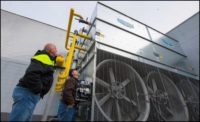Since opening in November 1929, Northrop Auditorium has served the University of Minnesota as a venue for music, dance, traveling roadshows, and convocations in its auditorium. Although not officially on the National Register of Historic Places, the building is register-eligible. Thus Historic Preservation authorities scrutinize any modifications proposed and made to the historic structure.
The auditorium originally seated roughly 4,800 patrons for concerts. Sight lines from the upper balcony, however, were compromised by very long distances from seats to stage. Acoustically, the auditorium was also compromised in a concession to seat count. In order to bring new life to the aging facility, the auditorium was reinvented from 2009 to 2014. The interior of the building was gutted, with the exception of the Historic Preservation Zones that were established at the project outset, which included the Memorial Hall lobby and staircases accessing the upper three floors of the facility. The proportions of the auditorium were significantly revised, narrowing the space and adding verticality. The original single deep balcony was removed and replaced with three balconies.
Through this process, the seat count was reduced to 2,800, but acoustics were significantly improved for all patrons. Sight line distances were reduced from a maximum of roughly 225 ft to 125 ft, with fewer than 17% of patrons seated outside of an optimum of 100 ft. Square footage picked up along the sides of the auditorium (due to its narrowing) was allocated to permanent resident academic programs — which the facility has never had. Reopened in 2014, the new Northrop includes state-of-the-art systems to support superior acoustics while preserving the historic nature of the building.
Existing Systems
As was typical for buildings of Northrop’s vintage, the structure originally was only partially ventilated and air conditioned. The lobby, the auditorium/stage, and large rehearsal spaces under the stage were the only spaces with air-handling systems other than exhaust. All other areas of the building were a combination of operable windows and exhaust at restrooms with steam radiator heat throughout.
Originally designed around evaporative coolers, the air-handling units had been converted to central chilled water, and a 3,000-ton district chiller plant added to what was considered an underutilized basement and roof space. That central plant was a significant hurdle to the design and conceptualization of a revitalized building. Northrop’s central plant serves a large number of other buildings on campus, and taking it offline for any significant period of time was unacceptable.
Some of the equipment, including the free cooling condenser water heat exchanger system, was located in places that posed significant architectural hurdles, and moving them was cost-prohibitive. With the exception of the central plant, which was installed in phases since the mid-1990s, most of the systems within the building were well-maintained original equipment. Most of the distribution within the building shell was destroyed during demolition, and all of the mechanical and electrical systems in the building were removed and replaced during the course of the project.
Chilled beams & dual-wheel AHUs
In approaching the systems design for the revitalized Northrop, the mechanical engineers faced a daunting task in balancing the project’s energy-efficiency goals, budget, and spatial constraints. Much of the basement and first floor is support space for the auditorium, and includes changing rooms, offices, and storage spaces. As these portions of the building are dormant between events, they were placed outside of the “horseshoe” of program area around the centrally located auditorium/stage. The engineers anticipated a high exhaust load in these spaces, and they incorporated energy recovery into the air-handling systems to manage the high levels of exhaust without paying an undue energy penalty.
Chilled beam terminal units were also used to provide a thermally comfortable environment while minimizing total system airflow in the back of the house, and a dual-wheel energy recovery AHU was used to deliver air to the space. In a dual-wheel AHU, the first energy wheel that the incoming outdoor air “sees” removes sensible and latent energy. After passing through the wheel, the air is further cooled and dehumidified as necessary to achieve a dew point that prevents condensation on the surfaces of chilled beams in the offices and crew spaces. The final wheel is a passive reheating wheel, which warms the delivered air back up in order to prevent overcooling while maintaining a lower dew point in the spaces served. Since this reheating is achieved with energy recovery from the exhaust airstream, there is no additional heating energy penalty associated with this process.
With chilled beams in the ceiling, space dew points needed to be maintained at or below 54?F at all times, based on an entering water temperature of 58?F. The dual-wheel energy recovery air-handling unit was selected to be able to dehumidify down to a dew point as low as 50?F if needed. The delivered condition of the air can be maintained by modulating the rotational speeds of the energy wheels, as well as by modulating the heating and cooling control valves. Since some of the rooms with chilled beams also include operable windows, lockout controls were included to shut off tempered chilled water flow to the beams in that zone whenever a window was left open. Part of the lower level program also included large changing/shower rooms for performers leaving the stage. Rather than including beams in these moisture laden areas, they were served directly from the energy recovery DOAS without supplemental terminal cooling units — the air change rate in the room was high enough to condition without the added cooling.
Displacement Ventilation
The auditorium had always been fully conditioned. In the original space, air had been delivered from under the occupants’ feet through raised cast iron diffusers in the floor. While the mechanics of the diffusers were updated in the revitalized Northrop, the air delivery method remains the same. Displacement ventilation approaches for large auditoriums have been proven to be efficient, cost-effective solutions for air delivery in spaces that have very low background noise levels.
With terminal velocities below 50 ft per minute, no system noise is generated within the auditorium. Equipment noise was minimized by careful selection of the AHUs and fans with a little noise, coupled with judicious use of duct silencers in critical areas and low-velocity distribution ductwork. The dual wind tunnel 61,000-cfm AHU utilizes a fan array in which 12 smaller plenum fans operate in unison to deliver air to the space, rather than one or two much larger fans. The array allows a continually varied amount of air to be delivered to the auditorium to optimize indoor thermal conditions and energy-efficient operation. Turndown in the array is superior to single or twin fan units. All of the fans are on VFDs, and individual fans can be turned off when the required volume is below a level at which running all twelve is necessary. In addition, the smaller fans incorporate silencers in plane with the fan wheels, eliminating noise directly at its source.
The auditorium has been tested to NC-22 at full air delivery volume, and operates below NC-20 during most operating conditions. To conserve footprint on the building roof — which was extremely limited due to the geometry of the roof line — the air-handling systems for the auditorium and the public spaces were built with two vertically stacked air paths each, delivering double the airflow in the footprint of a much smaller air handler. Atypical for a historic renovation project, there was actually ample vertical height in the roof mechanical areaways on either side of the auditorium.
Atrium smoke control
Another challenge in the systems design for the revitalized Northrop was incorporating a full atrium smoke control system. The Memorial Hall lobby is, under today’s codes, an atrium since four floors are open to one another via the grand staircase on the east and west sides of the hall. The main lobby created from “found” space around the auditorium was also open on four floors — creating a second atrium volume that is partially contiguous with Memorial Hall.
To meet current building safety standards, atria must be provided with a means for removing smoke in the event of a fire so that occupants may exit the building safely. In Northrop’s case, this consisted of a total of five exhaust fans totaling 90,000 cfm. Makeup for this exhaust is introduced through doors on openers and through the AHU serving the public space around the auditorium. The most significant challenge in the HVAC design for this system was incorporating it seamlessly into both the newly remodeled spaces and the historic preservation zone of Memorial Hall. The system had to meet all of the code-required safety criteria while being invisible. Ultimately, most of the air is drawn through the ceiling of the new lobby space immediately adjacent to Memorial Hall through openings between the two spaces. The smoke layer height under design conditions remains well above occupant head levels based on fire modeling studies undertaken for proof of concept to demonstrate compliance to code officials.
History vs HVAC
Engineering systems for a performing arts center inside of a historic building presented its own unique set of challenges. First and foremost was maintaining a high level of sensitivity to the historic aesthetic of the building’s finished interior spaces. Careful design of the HVAC and lighting systems ensured these systems were as visually unobtrusive as possible, and included re-using air terminals when possible and re-wiring and re-lamping historic light fixtures.
In Memorial Hall, for example, chandeliers were removed and restored; air supply outlets were re-used and are visible only as slots in the vertical faces of ceiling coffers. Pieces of the stage’s original proscenium arch were preserved and reinstalled, or removed and re-crafted as architectural ornaments in the new lobby atrium. All return air in the public spaces is routed through the slatted ceiling at the top of the atrium. In addition, spatial challenges abounded during design and construction, including floors that were two inches lower in elevation than indicated in the original construction drawings.
During the coordination process, an unusually deep line of beams was uncovered that coincided with the construction of a temporary exterior wall that was halted in the late-1920s; as a result, all major trades had to submit drawings for review and approval prior to installation. With the low floor-floor height in the building, and the unexpected added depth of structural members along the grid line, a “no fly zone” was created, disallowing any passage of HVAC ductwork and piping on two floors.
Conclusion
The new Northrop opened on April 4, 2014, with a performance by the American Ballet Theater. In the months since opening, the hall has been more fully utilized than it has been in decades. With new permanent programs in residence in the building, a new vitality has been brought to the venerable anchor on the north end of the main mall at the University of Minnesota.





